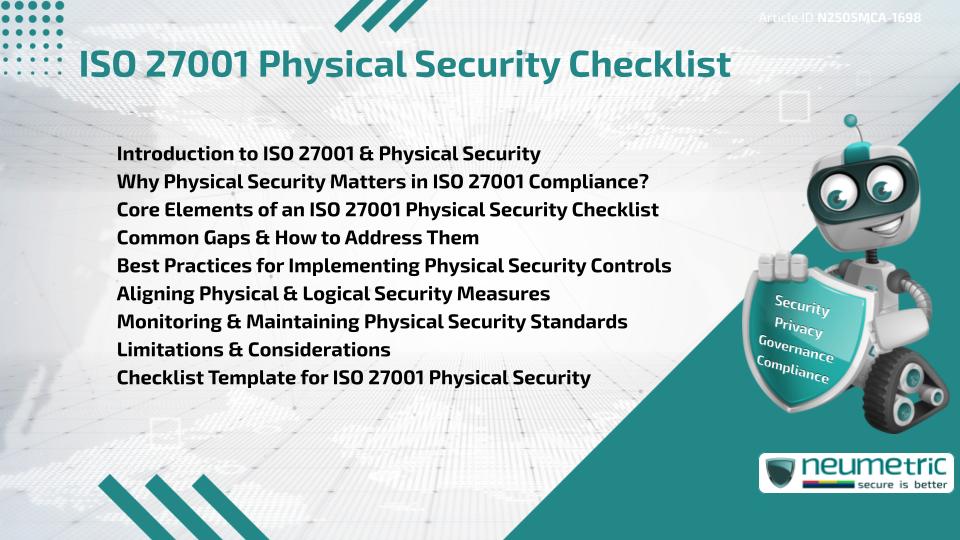Table of Contents
ToggleIntroduction to ISO 27001 & Physical Security
ISO 27001 is a globally recognised standard in establishing, implementing & maintaining an Information Security Management System [ISMS]. While many organisations focus heavily on digital threats, ISO 27001 also emphasises the importance of physical security. The standard requires that access to facilities, equipment & supporting assets be controlled to prevent unauthorised access, damage or interference.
A structured physical security checklist from ISO 27001 helps ensure these requirements are met consistently & thoroughly. This article explores the key features of the provided checklist & offers practical guidance for implementation.
Why Physical Security Matters in ISO 27001 Compliance?
Physical security is the first layer of protection in any effective security framework. If this layer is weak or overlooked, even the most advanced digital safeguards can be rendered useless. For example, an unlocked server room or unsecured printed documents can expose sensitive data to serious risks.
The ISO 27001 physical security checklist plays a key role in identifying & addressing these vulnerabilities. It helps organisations prevent incidents like theft, tampering, unauthorised entry & environmental damage. ISO 27001’s Annex A.11 clearly defines the required physical & environmental security controls, highlighting the importance of implementing & maintaining robust safeguards across all physical locations.
Core Elements of an ISO 27001 Physical Security Checklist
A well-structured checklist normally includes the below key areas:
- Access Control to Premises & Infrastructure: All the entry points in the premises should be secured with ID cards, biometrics or access codes.
- Visitor Management Procedure: Physical security includes registration, supervision & access restrictions.
- Physical Entry Controls: Barriers such as mantraps, turnstiles or guard checkpoints.
- Secure Offices, Rooms & Facilities: Limit access to sensitive areas like server rooms.
- Protection Against External Threats: Use fencing, locks, cameras & alarm systems.
- Equipment Security: Anchor laptops & secure desktops in locked offices.
- Power Supply & Cabling Security: Protect power lines & network cabling from interference or tampering.
- Environmental Controls: Fire detection, water leak prevention & temperature control systems.
Each of these areas aligns with ISO 27001 Annex A controls & helps reduce vulnerability to physical threats.
Common Gaps & How to Address Them
Many organisations fail ISO 27001 audits due to overlooked or inconsistent physical security practices. Common pitfalls include:
- No documented procedures for physical access.
- Lack of visitor logs or supervision.
- Unsecured backup storage.
- Shared access cards among employees.
- Absence of regular facility security reviews.
To address these, the checklist should include routine inspections, staff training & periodic updates to policies. Security awareness sessions should make these practices relatable & easy to understand.
Best Practices for Implementing Physical Security Controls
Implementation is not just about hardware. Here are a few best practices:
- Conduct a Risk Assessment: Identify critical areas & vulnerabilities.
- Assign Responsibility: Designate a facilities or security officer to manage checklist items.
- Train Personnel: Include physical security in onboarding & refresher training.
- Document Everything: Ensure logs, approvals & procedures are well maintained.
- Keep It Practical: Avoid overly complex setups that are hard to maintain.
For better outcomes, keep training content short & relevant. Tailoring it to daily activities helps employees remember & apply best practices.
Aligning Physical & Logical Security Measures
A major strength of the ISO 27001 physical security checklist lies in its integration with digital security controls. For example:
- Door access logs can be compared with system login records.
- Physical breaches can trigger alerts on the network.
- Surveillance footage can be correlated with suspicious activity reports.
This convergence ensures a holistic approach to information protection.
Monitoring & Maintaining Physical Security Standards
Physical security is not a set-it-and-forget-it task. It requires:
- Regular audits
- Incident reporting mechanisms
- Continuous improvement
- Feedback from employees & facility managers
A clear schedule should be established for reviewing physical control which includes mock drills for emergencies like fire or unauthorised access.
Limitations & Considerations
While a checklist is helpful, it cannot cover every scenario. Considerations include:
- Balancing security with employee convenience
- The cost of implementing advanced controls
- Adapting policies for hybrid or remote work setups
Understanding these limits ensures that the checklist remains adaptable & sustainable.
Checklist Template for ISO 27001 Physical Security
Below is a simplified version of what an ISO required checklist might consist:
- Are all entry points secured & monitored?
- Is visitor access logged & supervised?
- Are critical equipment areas access-controlled?
- Are power & data cables protected from tampering?
- Is fire suppression equipment maintained & inspected?
- Are employees trained on physical security protocols?
- Is physical access reviewed regularly?
- Are offsite backups securely stored?
This template can be adapted based on organisation size, industry & operational risks.
Takeaways
- Physical security is a critical component of ISO 27001 compliance.
- A detailed ISO 27001 physical security checklist simplifies implementation.
- Combining physical & digital controls strengthens your ISMS.
- Timely review & staff training are essential for lasting protection.
- Practical implementation tailored to real-world risks ensures both effectiveness & sustainability.
FAQ
What is the ISO 27001 physical security checklist?
It is a structured list of controls & procedures aimed at protecting physical access to sensitive areas, equipment & data as part of ISO 27001 compliance.
Who is responsible for maintaining the ISO 27001 physical security checklist?
Typically, a facilities manager or security officer ensures the checklist is implemented & maintained, with oversight from the ISO 27001 compliance team.
How often should physical security measures be reviewed?
Physical security controls should be reviewed at least annually or after any significant change in infrastructure, staffing or risk levels.
What are some examples of physical security controls?
Examples include access card systems, CCTV, biometric locks, secure storage for sensitive documents & environmental protections like fire suppression.
Can physical security be outsourced?
Yes, but outsourced vendors must also comply with ISO 27001 standards & should be regularly assessed for compliance & performance.
How does the checklist relate to Annex A.11?
In annex A.11 of ISO 27001 outlines requirements for physical & environmental security. The checklist helps ensure all of these areas are covered.
Is physical security still important in remote work setups?
Yes, because employees may still handle sensitive data at home or on mobile devices. Secure storage, device locks & screen privacy remain essential.
What if my organisation doesn’t have a dedicated security team?
Smaller organisations can assign security responsibilities to IT or administrative staff, provided they receive adequate training.
Do we need to log all visitors for ISO 27001?
Yes, maintaining accurate visitor logs is a core requirement for tracking physical access & ensuring accountability.
Need help?
Neumetric provides organisations the necessary help to achieve their Cybersecurity, Compliance, Governance, Privacy, Certifications & Pentesting goals.
Organisations & Businesses, specifically those which provide SaaS & AI Solutions, usually need a Cybersecurity Partner for meeting & maintaining the ongoing Security & Privacy needs & requirements of their Clients & Customers.
SOC 2, ISO 27001, ISO 42001, NIST, HIPAA, HECVAT, EU GDPR are some of the Frameworks that are served by Fusion – a centralised, automated, AI-enabled SaaS Solution created & managed by Neumetric.
Reach out to us!


